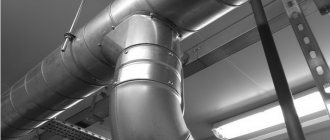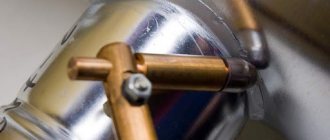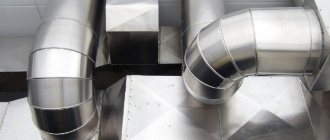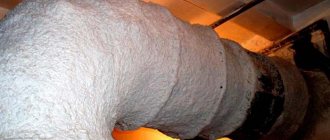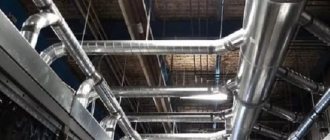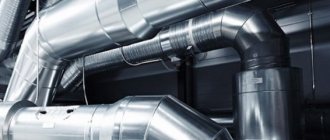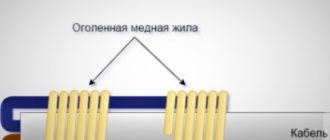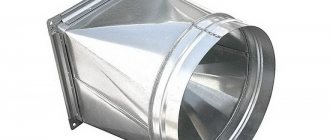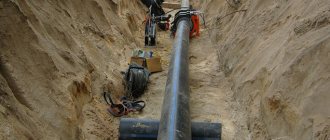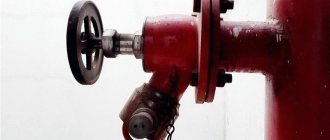Specifications
The main requirement for ventilation ducts is that they are made of galvanized steel sheet. Such elements have stood the test of time and have shown that there are no cheaper or better analogues today. And other characteristics that you need to pay attention to.
- The section can be in the form of a circle or a rectangle.
- The ends of the sheets are connected in the form of a welded or folded seam.
- The direction of connection of galvanized sheets is straight or spiral.
- The tightness class of either “N” or “P” can be used.
- Galvanized air ducts are used up to +80C.
- The thickness of the galvanized sheet used is from 0.5 to 1.25 mm.
- Diameter 100-1250 mm.
- Length 3-25 m.
How does the sealing process work?
To seal individual square and rectangular sections with flange (the most common) connections, gaskets or special compounds are used. The flanges are screwed together with bolts and nuts and the gasket is clamped.
Less common are bandage, coupling, nipple and socket connections (usually on round pipelines). They are usually sealed with special tapes and liquid sealants or non-drying mastics.
GOST
As mentioned above, all ventilation ducts are manufactured according to a certain state standard. In this case, galvanized sheets are used for production, which are produced under different GOST standards. The classification is based on the operating conditions of the ventilation pipes themselves. Eg:
- If air with a humidity of no more than 60% and a temperature of no more than +80C is passed through the ventilation, then a galvanized sheet made in accordance with GOST 14918-80 is used for the air ducts. In this case, material with a thickness of 0.5-1 mm is used.
- If the parameters of the transported air or gases are up to +500C, and they contain active chemical components, then the ventilation is assembled from pipes made of heat-resistant and corrosion-resistant steel, which is produced in accordance with GOST 5632-72.
The GOST designation is made in the quality certificate, which is issued for each batch of galvanized sheet.
Steel thickness for air ducts according to SNiP
This is a fairly serious indicator that determines the rigidity of the air ducts. And it depends on the diameter of the pipes being manufactured.
- diameter 80-315 mm – thickness of galvanized sheet used – 0.5 mm:
- diameter 355-800 mm – thickness 0.7 mm;
- diameter 900-1250 mm – thickness 0.9 mm;
- 1400-1600 mm – wall thickness 1.2 mm.
The thickness of steel for air ducts is one of the important parameters; it is not for nothing that it is precisely designated in SNiP. Therefore, when making ventilation pipes, you must strictly adhere to the above-mentioned ratios. At the same time, it should be noted that there is no difference what kind of pipes will be manufactured - class P or N air ducts. More on them below.
Duct weight
| Diameter, mm | Weight of one meter, kg |
| 100 | 1,4 |
| 125 | 1,8 |
| 140 | 2 |
| 160 | 2,3 |
| 180 | 2,5 |
| 200 | 2,8 |
| 225 | 3,2 |
| 250 | 3,6 |
| 280 | 4 |
| 315 | 4,5 |
| 355 | 5,1 |
| 400 | 5,7 |
| 450 | 9 |
| 500 | 10 |
| 560 | 11,3 |
| 630 | 12,7 |
| 710 | 14,3 |
| 800 | 16,15 |
| 900 | 26 |
| 1400 | 48,4 |
| 1600 | 55,3 |
Fire resistance limit
Galvanized air ducts must provide certain conditions for maintaining their parameters during fires and non-propagation of fire. For this purpose, there are fire resistance standards that divide all building materials into five classes. So, galvanized air ducts belong to class zero. Therefore, pipes laid under the ceiling must withstand the fire temperature for 90 minutes, and pipes laid along the walls - 30 minutes.
Fire resistance testing of air ducts is carried out at the facilities themselves where the ventilation and air conditioning system is being constructed. In this case, SNiP 2.04.05-91 is used. Methods of protection:
- traditional using foil material;
- applying protective fire-resistant compounds using equipment;
- combined method.
What it is?
Ventilation is the process of removing or replacing polluted air in a room and providing it with the necessary sanitary and hygienic conditions and creating a microclimate that is comfortable for humans. Tightness of air ducts - airtightness of ventilation ducts. It is tightness that ensures high-quality operation of the ventilation system and protects ventilated buildings from dangerous situations.
Marking
In SNiPs, on the basis of which ventilation and air conditioning systems are built, there are no strict requirements for the marking of air ducts. That is why builders do not carry it out. But many contracting organizations are silent or do not know that GOST 14202 clearly states that air ducts must be marked. If air is transported through them, then they should be painted blue on the outside. The appendix of this GOST indicates exactly what shade the blue paint should be.
In Europe and America, marking is mandatory. In Russia, at some facilities, installation organizations also carry out painting of air ducts if these facilities are constructed according to international standards.
How to check the tightness of air ducts
The installed air duct is checked using aerodynamic tests, during which the flow rates at the end points - grilles, diffusers - are recorded. As practice shows, such tests do not guarantee the required characteristics even with “normal” performance readings obtained.
This situation has arisen due to the inconsistency of regulatory documents from different years and the vagueness of definitions. For example, there is a requirement to inspect “individual sections of ductwork,” but there is no requirement to inspect the entire system.
It is important for the customer to take care of choosing qualified specialists (a third-party company for the builders) to check the tightness of both individual sections and the entire system as a whole.
Density classes
When understanding the density classes of air ducts, you need to understand that these transporting elements can be used in different systems: ventilation and air conditioning, air heating and smoke removal. That is, in some of these categories, increased density of elements and 100% tightness of connecting joints are required, therefore galvanized air ducts are divided into two classes.
Air ducts class "P"
A system of galvanized air ducts, marked with the letter “P”, that is, dense, is installed in ventilation, where powerful pumping equipment is used, creating a maximum air pressure of up to 1.4 kPa. Air ducts of class “P” have certain characteristics:
- connection density is high, for which sealants or other sealing materials are used;
- the presence of a sealed lock at the junction of two air ducts.
Such air ducts are used in almost all systems related to the removal of air and smoke, as well as when transporting gases. In addition, SNiPs recommend installation of this type in buildings that are classified as explosion and fire hazardous.
Class "N"
The letter “H” in the marking of galvanized air ducts indicates the word normal. That is, the most stringent requirements are not imposed on their connection. A certain amount of leakage is allowed. Therefore, air ducts of class “H” can be used in rooms of fire hazard category “B” or “G”, that is, with minimal indicators.
This does not mean that the joints between the air ducts are not sealed. Small leaks, cracks and other defects are simply allowed. Rubber is most often used for sealing.
Materials for sealing air ducts
The following types of seals are used to seal flanges:
- Asbestos cord.
- Chrysolite thread.
- Rubber.
- Asbestos cardboard.
- Acrylic mastics and sealants.
- Fireproof mastics and sealants.
- Thermal sealing tape.
- PVC plastic compound.
For all other types of connections, special tape, mastic, sealants are used, and sometimes the joints are glued with aluminum tape.
For reliability, you should always use two types of sealants - if one is destroyed, the second will seal the joint.
Tightness classes
The modern approach to properly organized ventilation is to ensure complete tightness of the air ducts. The density of this system was mentioned above. And these two classes can also be included in the tightness category. It is they who determine the work carried out in Russian construction organizations, because all this is indicated by SNiP 3.05.01-85.
It clearly states that there are several very important reasons why the tightness of galvanized air ducts is monitored.
- The effectiveness of a ventilation system decreases sharply when the airtightness of ventilation sections and pipes decreases. At the same time, repair and maintenance processes become more complicated. And since sanitary standards clearly stipulate what the air exchange should be in certain rooms, accordingly it is necessary to strictly adhere to the established requirements. This means that leaks have to be minimized.
- The insufficient supply of fresh air and the outflow of used air from the premises creates conditions in which a person is uncomfortable to be. In addition, it is harmful to health. Therefore, it is necessary to increase the power of application equipment. Which entails an increase in energy costs.
- If the tightness of galvanized air ducts is broken, and if the ventilation area is located in an unheated room, then there is a high probability of condensation forming inside the pipes.
In Europe they use their own document regulating the sealing of air ducts. It is designated as Eurovent 2.2. It has three classes of ventilation air duct tightness.
Class "A"
This is the lowest class of air duct tightness, which is determined by such an indicator as air tightness. So it should not be less than 1.35 l/sec/m, provided that the air pressure passing through the galvanized air ducts is 400 Pa.
Class "B"
This class includes air ducts with an air tightness of 0.45 l/sec/m at the same pressure of 400 Pa.
Class "C"
And the last class with an air tightness of 0.15 l/sec/m. As in previous classes, the air pressure in the system is 400 Pa.
Leak test
Regardless of whether a new ventilation system is being built or an existing one is being checked, it must be clearly understood that tests must be carried out. This is especially true for a working ventilation system that has become ineffective. For this purpose, aerodynamic testing technology is used. Not the easiest process, but you can’t do without it.
If deficiencies are identified, measures must be taken to eliminate them. Usually this is depressurization of joints. Therefore, it is necessary to re-seal by applying sealant, mastic or self-adhesive tapes.
Why do you need tightness control?
Monitoring the tightness of air ducts allows you to determine the quality of ventilation systems. It is this that allows you to determine efficiency, reduce the risk of breakdowns of various structural elements, and also avoid a decrease in operating pressure.
To control air ducts of the tight or normal class, it is necessary to involve specialized organizations engaged in this activity. An expert assessment independent of the construction company will determine whether there is any non-compliance with the requirements of current standards.
The main factors determining the need for control:
- Reduced sanitary standards and requirements, as a result of which not only the removal of gas combustion products may deteriorate, but also require partial or complete repair of ventilation ducts due to the consequences of a violation of their sealing.
- Leaky joints significantly impair the ventilation of rooms and increase the costs of its operation and maintenance, since in order to ensure the required performance it is necessary to increase the power of the equipment.
- The presence of even small loose joints in ventilation ducts can cause condensation to appear on internal surfaces, which can cause breakdowns of expensive equipment and systems.
Kinds
The broad classification of galvanized air ducts is due to their widespread use in various ventilation systems. Therefore, in order to make it convenient to somehow distinguish and classify them, the division was carried out according to the following parameters.
- The cross-sectional shape can be round, elliptical or rectangular.
- Diameter.
- Execution in a purely structural form: with a straight seam or a spiral one.
- Depending on the materials from which they are made: metal (galvanized or stainless steel), plastic, metal-plastic.
- Connection option: with or without flanges.
- Type of connection: couplings, tees, diffusers and other types of shaped parts of air ducts.
- Element stiffness.
Rectangular
Most often, rectangular or round shapes of air ducts are used in the design of ventilation systems. The former have one very important advantage - they can be adjusted to the necessary conditions of the structure. That is, taking into account the architectural delights of the room, you can reduce the height of the air duct, but increase the width, thereby leaving the cross-sectional area unchanged. The latter plays the most important role in design and calculations. It is the cross-sectional area that ensures the unhindered movement of the required amount of air through the ventilation system.
For example, if there is a need to lay ventilation ducts under a suspended ceiling, then you just need to change the dimensions of the rectangular section. That is, increase the width and decrease the height as required so that the cross-sectional area does not change. For example, we can give this ratio - 20x20 cm, and a modified one - 10x40 cm.
Most often, rectangular air ducts are installed in residential and office buildings. They try to use them in systems with low air speed, because turbulence occurs in the inner corners of the air duct, which leads to a drop in speed, and therefore to a decrease in the efficiency of ventilation as a whole.
Round
Round air ducts made of galvanized steel, firstly, are easier to manufacture. At the same time, they require 20-30% less metal. Secondly, such pipes can be as long as possible. Let us add that turbulence does not appear inside round pipes, hence the efficiency of ventilation, optimal air speed, low noise level and ease of installation work. By the way, the last criterion ensures low weight of the elements due to the use of less metal.
Such air ducts are most often used in industry, when there is a need to assemble an extensive ventilation network with minimal material costs. Although no one prohibits using them in residential construction.
Straight-seam
Straight-seam air ducts are used mainly in industrial facilities. Their main difference from other varieties is a straight seam along the entire length of the pipe. They are made from galvanized iron with a thickness of 0.5-1.2 mm and an average length of 1.25 m.
For rectangular air ducts, the seam is placed on a bend, which gives the structure additional rigidity.
Spiral wound
Essentially, this is a metal strip that is curled into a pipe in a spiral, and its edges are connected to each other. Today, manufacturers of galvanized air ducts offer two types of such structures.
- Spiral welded. From the name it becomes clear that the edges of the tape are connected to each other by welding, which makes the seam strong and airtight. For this, a tape with a thickness of 0.8-2.2 mm and a width of 400-750 mm is used. It is possible to make pipes from it, the length of which is limited only by the consumer’s order. It should be noted that for the production of such air ducts, a tape coated with an anti-corrosion layer is used.
- Spiral-lock. For them, the same tape is used only with a thickness of 0.5 to 1 mm and a width of 130 mm with slight deviations. As in the first case, the length is not limited.
The production technology of spiral-type air ducts itself is divided into two categories: in a tape or in a ring. It should be noted that the second technology is considered more expensive, but the quality of such pipes is much higher.
Corrugated
This type of air duct came into use relatively recently. These are mainly pipes coated with aluminum alloy or polymer. In this case, corrugations are divided into flexible and semi-flexible.
The former are distinguished by such a property as stretching the air duct and returning it to its previous state without loss of technical qualities. Essentially, it is a spiral of wire on which an aluminum or polymer layer is stretched. Or a combination of both. Foil, films made of polyvinyl chloride, polyester or polyurethane are used as shells.
The second are air ducts assembled using spiral laying technology. The material used is galvanized steel, stainless or aluminum tape. They come to the market in compressed form, the length of which can reach up to 3 m. And they usually stretch three times longer. These air ducts themselves are very flexible, but what distinguishes them from the first model is the fact that after stretching, it is impossible to put them back together.
Insulated
It is imperative to insulate air ducts located in unheated rooms and outdoors. What are various thermal insulation materials used for? The insulation process itself involves a large amount of work, which takes time. Today, manufacturers offer corrugated air ducts, which are insulated at the factory during their manufacturing process. For this, aluminum foil and polymer compounds are most often used.
Materials
Galvanized air ducts are most often used. They are installed in a ventilation system that pumps air up to a temperature of +80C without aggressive components.
Stainless steel air ducts are the most expensive material, so they are used very rarely. This requires special operating conditions for the ventilation system: temperature +500C, aggressive gas or air composition.
Metal-plastic pipes are a layered structure of the product, where a plastic component is laid between two layers of aluminum. Positive factors include low specific gravity and attractive appearance. In addition, these air ducts belong to the insulated category. The only drawback is the high price. Metal-plastic air ducts are mainly used in ventilation systems installed in the chemical, pharmaceutical and food industries.
Today, manufacturers offer air ducts from other materials. For example, their polyethylene, fiberglass. The latter often appear in the form of a shaped product, with the help of which the fan and distribution chamber can be connected to each other. Ventilation pipes made of vinyl plastic are installed in chemical industries when acidic vapors are present in the atmosphere. Note that this type is a very flexible material that does not corrode.
